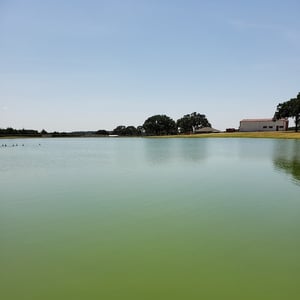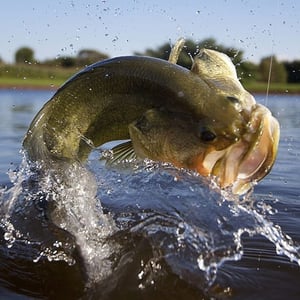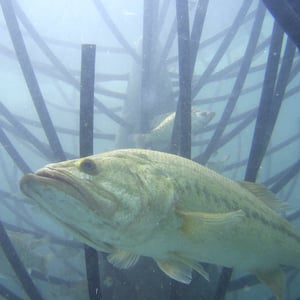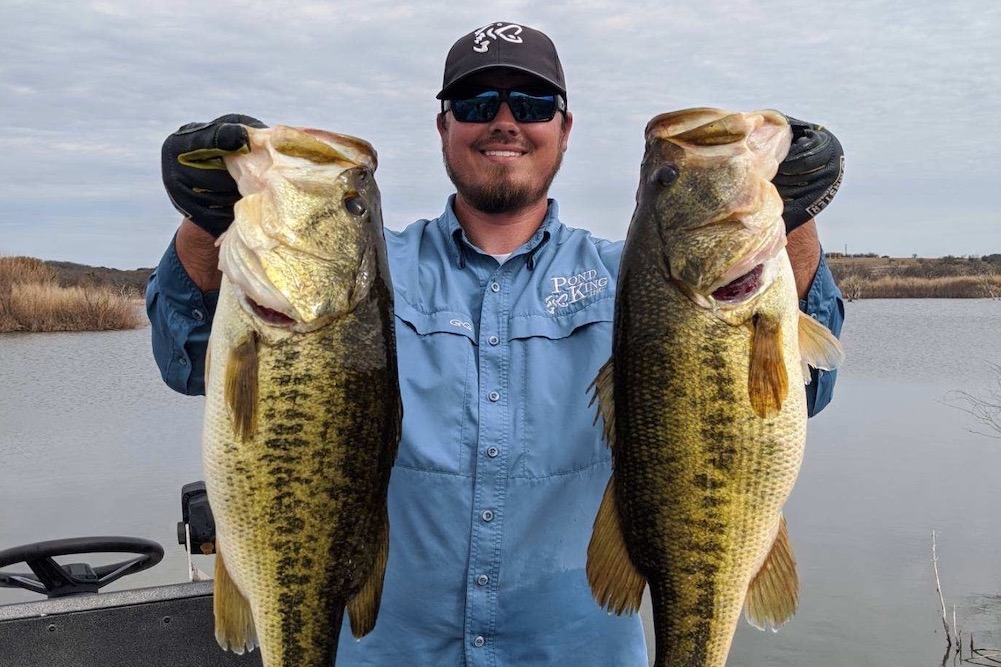Trying to raise trophy-class bass? Read on to learn more about the three pond management techniques that will get you the most bang for your buck when it comes to bass production.
If you could only do one thing to impact bass production, what would it be?
Folks call all the time asking for advice on how to manage ponds or lakes to grow trophy-class bass. In fact, most of our pond management customers hire us to help them either build or manage a bass fishery. After more than 25 years of experience managing for bass in Texas and Oklahoma, we've learned a couple of things:
- There is no one right or wrong way to manage a pond,
- Not everyone who has a pond or lake is managing for trophy-class bass production,
- If you are trying to impact your bass production, these are the top management techniques we recommend to impact bass production.
Not all ponds are created equally
Before we get to our top three recommended pond management techniques, it is important to remember, no two lakes or ponds are alike. Their age, physical profile, aquatic species population, size and your desired goals can dramatically impact the pond management plan to achieve optimal bass production. That said, there are certain management techniques we recommend in most circumstances because they are relatively inexpensive and reliably effective.
Increase Food Production
 There are essentially two ways you can increase food production; fertilization and supplemental feeding. Fertilization is a simple but very important step to get the most out of your lake. Fertilizing facilitates a bloom of phytoplankton. Phytoplankton are fundamentally important to your ecosystem because they are a source of primary productivity. This means they manufacture organic matter out of the inorganics nutrients in the environment. In other words, they are the very base of the food chain and supply energy throughout the ecosystem. By inducing a bloom of phytoplankton, you are supercharging your ecosystem with potential sources of energy leading to improved growth and growth rates of all fishes. Fertilizing is suggested in lakes greater than 2 acres. In ponds less than 2 acres, substitute fertilization with a supplemental feeding program for your bluegill. In small ponds bluegill are often the primary forage for game fishes and by implementing a feeding program you will increase the broodstock density and have greater recruitment after each spawning event. This will create a solid sustainable foundation of your ponds food chain.
There are essentially two ways you can increase food production; fertilization and supplemental feeding. Fertilization is a simple but very important step to get the most out of your lake. Fertilizing facilitates a bloom of phytoplankton. Phytoplankton are fundamentally important to your ecosystem because they are a source of primary productivity. This means they manufacture organic matter out of the inorganics nutrients in the environment. In other words, they are the very base of the food chain and supply energy throughout the ecosystem. By inducing a bloom of phytoplankton, you are supercharging your ecosystem with potential sources of energy leading to improved growth and growth rates of all fishes. Fertilizing is suggested in lakes greater than 2 acres. In ponds less than 2 acres, substitute fertilization with a supplemental feeding program for your bluegill. In small ponds bluegill are often the primary forage for game fishes and by implementing a feeding program you will increase the broodstock density and have greater recruitment after each spawning event. This will create a solid sustainable foundation of your ponds food chain.
Reduce Competition
 Annual harvest of bass in a pond is something that many people overlook because it seems to contradict the goal of raising trophy-class bass. Why take bass out when you are trying to grow bass? The answer is carrying capacity. Carrying capacity is the maximum number of individuals an ecosystem or environment can support. When at or greater than carrying capacity, growth rates and population growth significantly decrease and can halt in some scenarios (stunted populations). Overcrowding and overpopulation are terms you may be more familiar with. Both are based on the fundamental principle of carrying capacity. When populations reach carrying capacity, resource availability for each fish is reduced, as a larger percentage of available resources will be utilized by other members of the population. By maintaining fish population below their carrying capacity your fish will exhibit improved growth rates and increased reproductive success leading to larger fish in the future.
Annual harvest of bass in a pond is something that many people overlook because it seems to contradict the goal of raising trophy-class bass. Why take bass out when you are trying to grow bass? The answer is carrying capacity. Carrying capacity is the maximum number of individuals an ecosystem or environment can support. When at or greater than carrying capacity, growth rates and population growth significantly decrease and can halt in some scenarios (stunted populations). Overcrowding and overpopulation are terms you may be more familiar with. Both are based on the fundamental principle of carrying capacity. When populations reach carrying capacity, resource availability for each fish is reduced, as a larger percentage of available resources will be utilized by other members of the population. By maintaining fish population below their carrying capacity your fish will exhibit improved growth rates and increased reproductive success leading to larger fish in the future.
Enhance Cover
 Habitat availability and selection in your pond can play a significant role in your ability to grow trophy-class bass because it provides cover to juvenile fish trying to avoid predation, and ambush opportunities for mature fish looking for their next meal. Consider adding the appropriate habitat for your fish to utilize during each season thereby allowing them to be more effective predators, spending less energy chasing and more energy growing.
Habitat availability and selection in your pond can play a significant role in your ability to grow trophy-class bass because it provides cover to juvenile fish trying to avoid predation, and ambush opportunities for mature fish looking for their next meal. Consider adding the appropriate habitat for your fish to utilize during each season thereby allowing them to be more effective predators, spending less energy chasing and more energy growing.
Spring: Largemouth bass will lay eggs in most types of shallow substrate, but hard substrate such as rock or gravel is often prefered. Proper “nursery” habitat near spawning areas increases survivorship of larval and juvenile fish and results in greater recruitment following spawning seasons. Nursery habitat is often protected shallow aquatic vegetation such as rushes or American Pondweed. Those are most important in spring and early summer months.
Summer and Winter: As water warms in summer fish transition to deeper cooler water near a thermocline or shallow vegetation where there is greater oxygen concentrations. Habitat in the 10-foot range in most ponds will be adequate. Brush piles or standing trees are good choices for this kind of habitat. These areas will often be used again as wintering habitat.
Fall: In fall, the fish migrate back shallow chasing forage into coves and creeks. By creating staging areas (laydowns, brush piles, rock piles) half way back in coves and creek arms allows predator fish to ambush prey moving up and pulling out of those creeks and coves.
Adequate habitat for all seasons allows your fish to be more effective year-round predators.
These are three of the most beneficial practices for a landowner to consider incorporating into their management plans. By implementing these techniques into your pond management regime, you can easily help your pond boost its potential yield of fish and lead to more reliable fishing experiences and hopefully that 10+ pound bass. If you have questions, remember you can always email me at ethan@pondking.com. And, you can also use our DIY Pond Management App to record and evaluate your bass population.
See y’all down at the pond.



